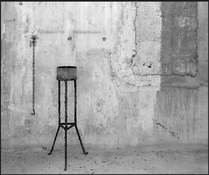No disrespect Andy, but this isn't a well controlled test. To do a well controlled test you should take pictures of a relatively flat subject, and refocus after adjusting the floating element ring (which you may have done but it wasn't clear in the video).
I believe a major point of a floating element adjustment is to compensate for field curvature. Field curvature can change significantly as a function of focus distance, that is a lens with a fairly flat field at infinity might have a fairly curved field at 1 meter. This is one reason that normal fast lenses often make poor macro lenses. However, it also means that to see the effect of the floating element it would be clearer to take pictures of a flat subject as Matt pointed out.
Field curvature is not really improved by stopping down, because it has to do with the position of the focused image, not with the size of the focused spot. That is, the central zone of the lens and the outer zone are focusing the image at more or less the same place, so stopping down to eliminate the outer zone doesn't undo the field curvature. Stopping down at best encompasses the curvature with the depth of field. This is one reason a lens designer would try to address curvature with a floating element.
Distortion is also not addressed by stopping down, because again it is caused by the position of the focused image. Front element converters and closeup lenses can have a lot of distortion, so that's probably what Donald saw.
Yes, I realise that now. I'm learning as I go. And yes, I do adjust the ring in the video. But in reality, who photographs a flat field one metre away from the film plane?? The dial only shows corrections from one metre to infinity...









 Just kidding!
Just kidding!

